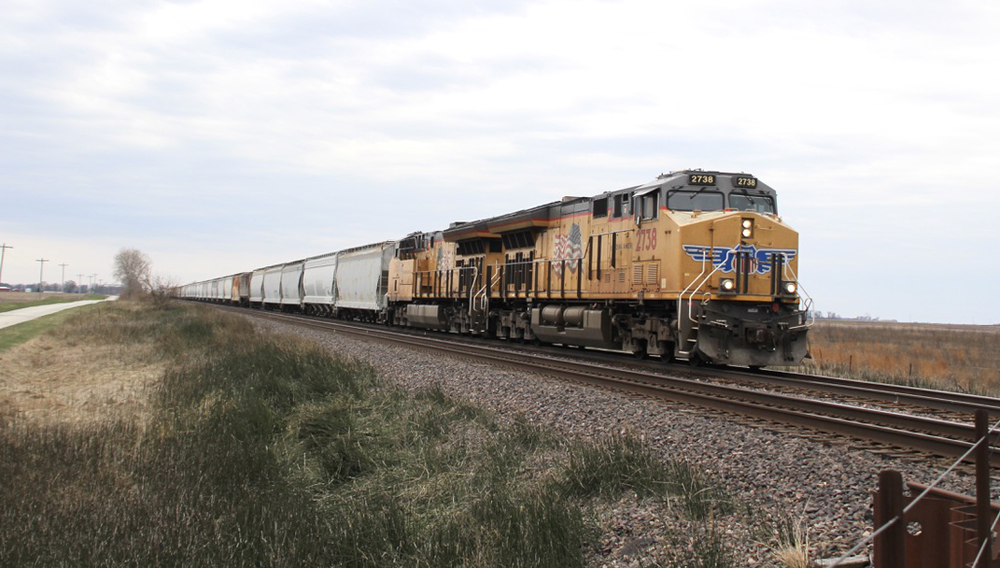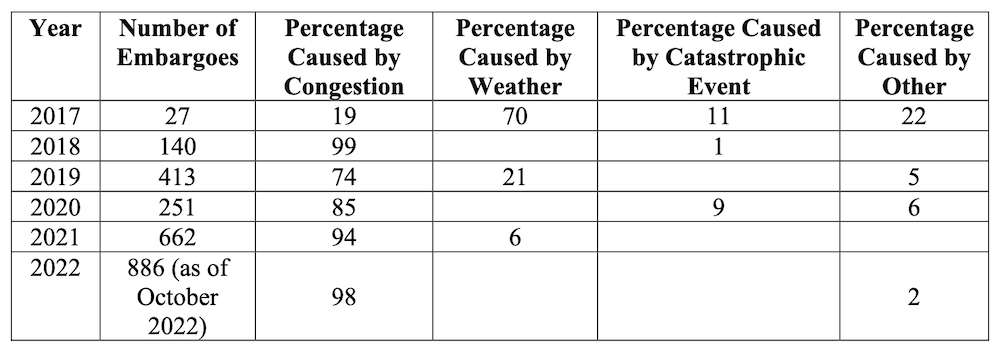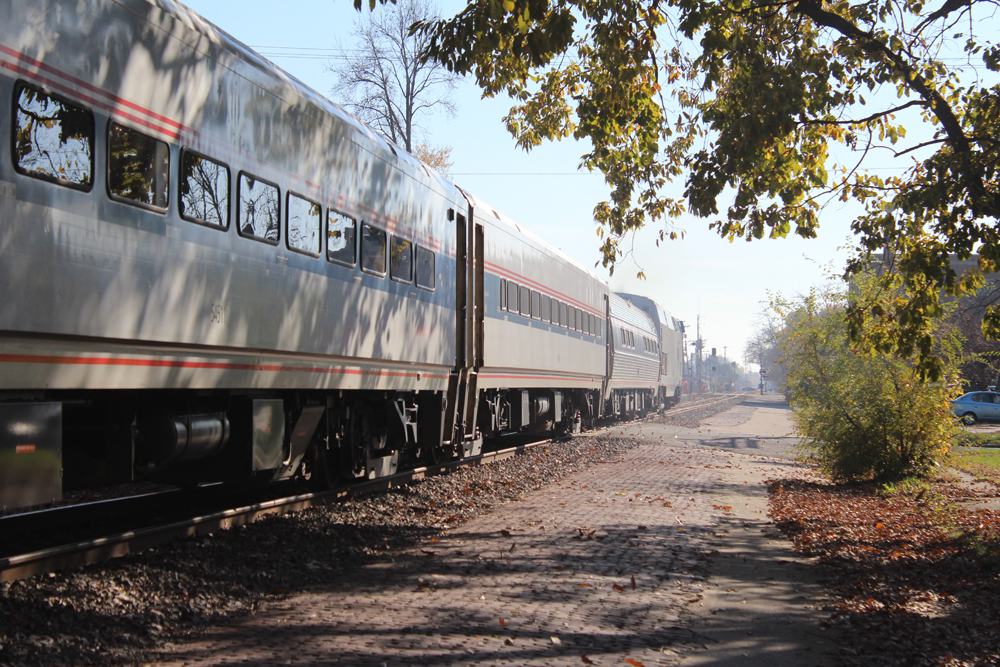
WASHINGTON — Federal regulators have ordered Union Pacific executives to appear at two days of hearings next month regarding the railroad’s increased use of embargoes, which have skyrocketed from 27 in 2017 to 886 as of October this year.
“The Board has been closely monitoring UP’s recent use of embargoes and has observed a disturbing upward trend in their usage,” the Surface Transportation Board said in a decision today. “In recent years, there has been a significant increase in UP’s use of embargoes, and congestion is the stated cause for almost all of the embargoes.”
The board’s decision includes a tally of UP’s embargoes, including their causes, since 2017.

“This pattern shows no signs of abating,” the board said, noting it was concerned about how disruptions on Union Pacific affect the broader supply chain and the U.S. economy.
The STB ordered top UP brass to appear at hearings set for Dec. 13 and 14 at the board’s headquarters.
“The Board understands that embargoes may vary in scope and that all carriers do not report and use embargoes in the same way. Nevertheless, the use of embargoes by all other Class I carriers, combined, pales in comparison to the number of embargoes issued by UP. Given UP’s sizeable role in freight rail, its increased use of embargoes in recent years, and the considerable increase just this month, it is imperative that the Board hear from UP directly about this matter and how UP plans to reduce, if not eliminate, the use of embargoes to control congestion,” the STB said.
UP imposed an additional 126 embargoes between Nov. 1 and Nov. 17 – including 89 issued on Nov. 16.
Earlier this month UP told certain customers it will meter traffic to limit congestion if they don’t voluntarily reduce the number of private freight cars operating on the railroad. Meanwhile, UP has increased the number of railroad-owned cars in storage.
“We are working with a small number of customers with excess private cars on our network to help them reduce their rail car inventories,” Kenny Rocker, the railroad’s executive vice president of marketing and sales, wrote in an update to customers on Monday.
UP made a similar move in April, when it also was facing congestion due to the impact of crew shortages. As a railroad slows down, and shippers see transit times go up, they typically use more freight cars to ensure their supply chains are not interrupted. But that only exacerbates congestion.
“Since my last update to you in October, our network performance had some setbacks, and our service product is not yet at the levels that we want them to be. Demand for our bulk commodities continue to remain strong – however, operating inventory for our manifest business is climbing at a faster rate than our carloads in key areas of the network where resources remain tight,” Rocker wrote. “As history has shown, additional inventory leads to more congestion in yards, an imbalance of our resources, and further slowdown of our operational performance.”
In a statement, UP defended its use of embargoes as a way to mitigate congestion.
“Union Pacific welcomes the opportunity at the upcoming STB hearing to explain the robust process we use to regularly monitor our network for elevated railcar inventory levels and the action we are taking to protect the nation’s supply chain,” railroad spokeswoman Kristen South says. “Due to our unique geographic span, number of yards, customer facilities, and commodity mix, embargos are one of the few tools, and last steps, to manage and meter customer-controlled railcar inventory levels, helping alleviate network congestion. We also reduce Union Pacific-controlled railcar inventory as demand ebbs and flows. By working with customers one-on-one to understand their evolving needs, many concerns can be resolved as customers act to better align supply and demand; however, in some cases for a small percentage of customers, we create embargos that allow Union Pacific to fairly serve everyone.”
Among the things the board expects UP executives to explain: Why embargoes have increased dramatically since 2017, whether the railroad has maintained sufficient resources, and whether UP considered the impact of embargoes on its common carrier obligations.

The board ordered UP to preserve all records related to its embargoes and invited shippers and other stakeholders to appear at the hearing. The board is requiring UP CEO Lance Fritz, Rocker, Executive Vice President of Operations Eric Gehringer, and Vice President of Customer Care and Support Bradley Moore to participate in the hearing.
Last week STB Chairman Martin J. Oberman was critical of railroads’ increasing use of embargoes over the past five years, a period when they dramatically cut the number of train and engine employees.
“The number of embargoes has skyrocketed in recent years,” Oberman told the RailTrends conference in New York. “It used to be that railroads implemented embargoes due to unforeseen natural disasters — bridge washouts, forest fires, polar vortexes. But no more. For some Class I [carriers], embargoes now are being used as a routine part of their operating plans.”
Through Sept. 30 of this year, the Class I railroads have issued a combined total 1,115 embargoes, he says.
“The vast percentage of these embargoes, over 80%, are the result of what the railroads call congestion — a railroad euphemism for ‘we don’t have enough crews to move our trains and keep our network fluid,’” Oberman says.
– Updated at 3:54 p.m. Central Time with statement from Union Pacific.














Aside from making Hedge Funds, short term investors, Wall St and RR CEOs richer, what has PSR done for the actual operations of the railroads? EHH is dead and buried, its time to do the same to PSR.
Double AMEN!!!
According to Lance in the same article, PSR is dead. UP, and other railroads, did what the government does, they renamed it. At NS, its their TOP-21 program.
I recall reading about Saunders and Perlman at Pennsy and NYC, respectively. Saunders was of the opinion Pennsy was a railroad, damn-it. You need to conform to our operations. Perlman at NYC was about expanding rail options for shippers. Perhaps that is one of the reasons PC failed from the start.
In a way, the “Railroad Way” has always been around. Like a mole popping up over and over again, PSR has always been out there. Like the mole, it just changes its names each time it pops up.
Until PSR, and its renamed iterations, stop making big money for Wall Street and huge bonuses for CEOs, it will be around until the Feds re-regulate the railroads. Then, I fear, it will be too late for the railroads.
Jim Young knew how to run a railroad, but he retired in 2012, having cancer, and died in 2014.
What happened in 2017? EHH became the CEO of CSX on March 17, 2017.
Since that date, every Class I rolled out their own version of PSR in an attempt to reach some magically low OR. In a January 16, 2020, article, Lance Fritz stated that shippers ready to work on the UP’s terms took things in stride. The others, he stated they were still angry. (Supply Chain January 16, 2020) Is that hubris or what?
In the same article, Fritz commented that the UP would have one primary service; no boutique service. That is a kind way of saying it’s our way or the highway.
Harrison was notorious for wanting to run the railroad his way and not the shippers’ way. It’s back to the old days when the operating department was completely in control. A main reason the Santa Fe (and BNSF) made intermodal a very profitable and growing business was that they hired people from the trucking industry.
And the railroads wonder why they can’t increase business.
I am still trying to figure out out they got a 25mph hospital train across their system when it is as stated “congested and understaffed”.
Well…they did divert it off of their system sooner than planned due to crew shortages, so there’s that.
Off topic, but is anyone having difficulty with this web site? Trains web site is so darned slow for me but all the other things I do are just fine. Just this one.
I’ve had that before on this site. If you’re using a desktop sign out and shut down your desktop for a couple minutes, then fire it back up and sign back in. It worked for me doing it that way a couple months back.
UP is in the hands of Wall Street short term money makers…..not service by rail business men. Look at what just happened last week. UP can’t deliver even it’s own shipment, having to deliver their donated museum items by TRUCK!
I did have that wrong about the museum pieces…….they did NOT go by truck!!!
They need to erase or revise the slogan, “We can handle it” off every piece of equipment.
Is there anyone out there who truly knows how to run a railroad? Look at UP’s past leaders: Kenefick; Davis; Davidson; where are they now? They would be shocked!
The reason is simple: as Oberman is stating, it’s about blaming the shippers for problems that are of its own making.
UP cut too deep into their own workforce, management, locomotive fleet, infrastructure, maintenance and local service, and is now unable to handle traffic that it used to handle well before implementing PSR.
Kenny Rocker hinted at the problem when he said this: “As history has shown, additional inventory leads to more congestion in yards, an imbalance of our resources, and further slowdown of our operational performance.”
In other words, they are more concerned about their operating ratio, the worst thing that ever happened to the railroads in the US, than they are complying with the STB orders to get more crews hired, especially engineers and conductors. I am afraid that the STB is going to have to set minimum standards for crew resources based on a metric they can hold the railroads to. Maybe it will be based on number of active miles currently in the systems under their direct control or something similar with escalator clauses that specifically states when they have to increase their crew numbers. It would be like how a lot of public service commissions function in regulating energy costs in many states,
Railroads want to avoid re-regulation. But if they keep messing with shippers only to enrich themselves, that is what will happen.